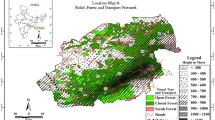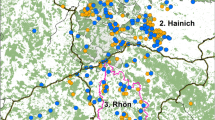Abstract
Although the impacts of the legal and illegal wildlife trade are broadly recognised for flagship species (e.g., elephant, rhino and tiger), less is known about how exploitation affects more common, and less charismatic species. This is of especial concern in Asia in general, and particularly in China, where demands for wild game species, and derived products are increasing, but a lack of data on illegal bushmeat hunting limits the development of effective species and ecosystem conservation measures. Genetic monitoring provides an informative tool to assess the pressures on regional populations, particularly for species that are difficult to monitor, for example, using arboreal or subterranean refugia. Here, using microsatellite markers, we investigated the effect of hunting on the genetic diversity of a regional population of the hog badger. Samples were collected from hog badgers confiscated from illegal traffickers and local hunters by forest authorities in the market towns of Wufeng and Yuguan, which lie 40 km apart in Hubei Province, China. To isolate novel hog badger microsatellite loci, we constructed a biotin-enriched microsatellite DNA library. Furthermore, we also tested the suitability of microsatellite loci designed for the European badger in the hog badger. Using these microsatellite markers, we found that these seized hog badgers exhibited a high level of genetic diversity—mean alleles per locus (A) were 8.33 and mean expected heterozygosities (H E) were 0.77. Despite 40 km separation between sample sites, spatial segregation was not apparent from genetics. This suggests that our confiscated hog badgers belong to the same meta-population. Although limited by a lack of geographical data on the source of these hog badgers, preventing the analysis of isolation by distance effects, hunting likely eroded hog badger population social structure, promoting gene flow among demes. We conclude that the exploitation of this wild source population seems unsustainable.


Similar content being viewed by others
References
Alacs EA, Georges A, FitzSimmons NN, Robertson J (2010) DNA detective: a review of molecular approaches to wildlife forensics. Forensic Sci Med Pathol 6:180–194
Amos W, Harwood J (1998) Factors affecting levels of genetic diversity in natural populations. Philos Trans R Soc Lond B 353:177–186
Annavi G, Dawson DA, Horsburgh GJ, Greig C, Dugdale HL, Newman C, Macdonald DW, Burke T (2011) Characterisation of twenty-one European badger (Meles meles) microsatellite loci facilitates the discrimination of second-order relatives. Conserv Genet Resour 3:515–518
Anon (2010) Understanding the motivations: the first step toward influencing China’s unsustainable wildlife consumption. Traffic East Asia Report, Hong Kong
Belkhir K, Borsa P, Chikhi L, Raufaste N, Bonhomme F (1996–2004) GENETIX 4.05, logiciel sous Windows TM pour la génétique des populations. Laboratoire Génome, Populations, Interactions, CNRS UMR 5000, Université de Montpellier II, Montpellier (France)
Bijlsma R, Van De Vliet M, Pertoldi C, Van Apeldoorn RC, Van De Zande L (2000) Microsatellite primers from the Eurasian badger, Meles meles. Mol Ecol 9:2215–2216
Bloor PA, Barker FS, Watts PC, Noyes HA, Kemp SJ (2001) Microsatellite libraries by enrichment. http://www.genomics livacuk/animal/Protocol1html
Carpenter PJ, Dawson DA, Greig C, Parham A, Cheeseman CL, Burke T (2003) Isolation of 39 polymorphic microsatellite loci and the development of a fluorescently labelled marker set for the Eurasian badger (Meles meles) (Carnivora: Mustelidae). Mol Ecol Notes 3:610–615
Carter SP, Delahay RJ, Smith GC, Macdonald DW, Riordan P, Etherington TR, Pimley ER, Walker NJ, Cheeseman CL (2007) Culling-induced social perturbation in Eurasian badgers Meles meles and the management of TB in cattle: an analysis of a critical problem in applied ecology. Proc R Soc B 274:2769–2777
CITES 2013. The CITES appendices. http://cites.org.cn/database/index.php. View 5 March 2014
Dawnay N, Ogden R, Thorpe RS, Pope LC, Dawson DA, McEwing R (2008) A forensic STR profiling system for the Eurasian badger: a framework for develo** profiling systems for wildlife species. Forensic Sci Int Genet 2:47–53
DeMATTEO KE, Rinas MA, Argueelles CF, Holman BE, Di Bitetti MS, Davenport B, Parker PG, Eggert LS (2014) Using detection dogs and genetic analyses of scat to expand knowledge and assist felid conservation in Misiones, Argentina. Integr Zool 9:623–639
Domingo-Roura X, Macdonald DW, Roy MS, Marmi J, Terradas J, Woodroffe R, Burke T, Wayne RK (2003) Confirmation of low genetic diversity and multiple breeding females in a social group of Eurasian badgers from microsatellite and field data. Mol Ecol 12:533–539
Earl DA, vonHoldt BM (2012) STRUCTURE HARVESTER: a website and program for visualizing STRUCTURE output and implementing the Evanno method. Conserv Genet Resour 4:359–361
Excoffier L, Lischer HE (2010) Arlequin suite ver 3.5: a new series of programs to perform population genetics analyses under Linux and Windows. Mol Ecol Resour 10:564–567
Fa JE, Peres CA, Meeuwig J (2002) Bushmeat exploitation in tropical forests: an intercontinental comparison. Conserv Biol 16:232–237
Frantz A, San EDL, Pope L, Burke T (2010) Using genetic methods to investigate dispersal in two badger (Meles meles) populations with different ecological characteristics. Heredity 104:493–501
Guo SW, Thompson EA (1992) Performing the exact test of Hardy-Weinberg proportion for multiple alleles. Biometrics 48:361–372
Harris RB, Wall WA, Allendorf FW (2002) Genetic consequences of hunting: what do we know and what should we do? Wildl Soc Bull 30:634–643
Helgen KM, Lim NTL, Helgen LE (2008) The hog badger is not an edentate: systematics and evolution of the genus Arctonyx (Mammalia: Mustelidae). Zool J Linn Soc 154:353–385
Hu RL, Zhang SF, Liu Y (2012) Suggestions on rabies prophylaxis and control in China. Chin J Zoonoses 28:487–491
Kalinowski ST, Taper ML, Marshall TC (2007) Revising how the computer program CERVUS accommodates genoty** error increases success in paternity assignment. Mol Ecol 16:1099–1106
Lau MWN, Fellowes JR, Chan BPL (2010) Carnivores (Mammalia: Carnivora) in South China: a status review with notes on the commercial trade. Mammal Rev 40:247–292
Liu ZJ, Huang CM, Zhou QH, Li YB, Wang YF, Li M, Takenaka O, Takenaka A (2013) Genetic analysis of group composition and relatedness in white-headed langurs. Integr Zool 8:410–416
McDonald RA, Delahay RJ, Carter SP, Smith GC, Cheeseman CL (2008) Perturbing implications of wildlife ecology for disease control. Trends Ecol Evol 23:53–56
McNeely JA, Miller KR, Reid WV, Mittermeier RA, Werner TB (1990) Conserving the world’s biological diversity. IUCN, WRI, WWF-US, WorldBank, Conservation International, Gland, Switzerland/Washington, DC
Moura AE, Tsingarska E, Dabrowski MJ, Czarnomska SD, Jedrzejewska B, Pilot M (2014) Untrgulated hunting and genetic recovery from a severe population decline: the cautionary case of Bulgarian wolves. Conserv Genet 15:405–417
Nevo E, Beiles A, Ben-Shlomo R (1984) The evolutionary significance of genetic diversity: ecological, demographic and life history correlates. Springer, Berlin
Pope LC, Doming-Roura X, Erven K, Burke T (2006) Isolation by distance and gene flow in the Eurasian badger (Meles meles) at both a local and broad scale. Mol Ecol 15:371–386
Pritchard JK, Stephens M, Donnelly P (2000) Inference of population structure using multilocus genotype data. Genetics 155:945–959
Raymond M, Rousset F (1995) GENEPOP (version 1.2): population genetics software for exact tests and ecumenicism. J Hered 86:248–249
Rice WR (1989) Analyzing tables of statistical tests. Evolution 43:223–225
Royle NJ, Hill MC, Jeffreys AJ (1992) Isolation of telomere junction fragments by anchored polymerase chain reaction. Proc R Soc Lond B Biol Sci 247:57–67
Smith GC, Thulke HH, Fooks AR, Artois M, Macdonald DW, Eisinger D, Selhorst T (2008) What is the future of wildlife rabies control in Europe. Dev Biol 131:283–289
State Forestry Administration (2000) Checklist of terrestrial wildlife with important ecological, economic and scientific values under state protection. The Order No. 7 of State Forestry Administration proclaimed on August 1, 2000. State Forestry Administration, Bei**g, China
Tuyttens FAM, Macdonald DW (2000) Consequences of social perturbation for wildlife management and conservation. In: Gosling LM, Sutherland WJ (eds) Behaviour and conservation. Cambridge University Press, Cambridge, pp 315–329
Van Oosterhout C, Hutchinson WF, Wills DPM, Shipley P (2004) MICRO-CHECKER: software for identifying and correcting genoty** errors in microsatellite. Mol Ecol Notes 4:535–538
Wang S, **e Y (2004) China species red list, vol. 1. Red List, Higher Education Press, Bei**g
Woodroffe R, Donnelly CA, Cox DR, Bourne F, Cheeseman CL, Delahay RJ, Gettinby G, Mcinerney JP, Morrison W (2006) Effects of culling on badger Meles meles spatial organization: implications for the control of bovine tuberculosis. J Appl Ecol 43:1–10
Zhang L, Hua N, Sun S (2008) Wildlife trade, consumption and conservation awareness in southwest China. Biodivers Conserv 17:1493–1516
Zhang L, Zhou YB, Newman C, Kaneko Y, Macdonald DW, Jiang PP, Ding P (2009) Niche overlap and sett-site resource partitioning for two sympatric species of badger. Ethol Ecol Evol 2:89–100
Zheng SW, Li GH, Song SY, Han YP, Ma ZY (1988) Study on the ecology of sand badger. Acta Theriol Sin 81:65–72
Zhou YB, Buesching CD, Newman C, Kaneko Y, ** China. Biol Conserv 165:18–24
Zhou ZM, Zhou YB, Newman C, Macdonald DW (2014) Scaling up pangolin protection in China. Front Ecol Environ 12:97–98
Zhou YB, Chen WW, Buesching CD, Newman C, Kaneko Y, **ang MX, Nie CA, Macdonald DW, **e ZQ (2015a) Hog badger (Arctonyx collaris) latrine use in relation to food abundance: evidence of the scarce factor paradox. Ecosphere 6:art19
Zhou YB, Chen WW, Kaneko Y, Newman C, Liao ZH, Zhu XQ, Buesching CD, **e ZQ, Macdonald DW (2015b) Seasonal dietary shifts and food resource exploitation by the hog badger (Arctonyx collaris) in a Chinese subtropical forest. Eur J Wildl Res 61:125–133
Acknowledgments
We thank M. Li, B. S. Wang, J. Chen, S. Yuan, G. J. Liu, F. L. Shi, G. H. Jiang and X. Q. Zhu for their assistance during this research. We are grateful to the State Forestry Administration, China, and the Wildlife Conservation Station, Wufeng County Forestry Bureau in Hubei Province, for granting us permission to conduct this study. This work was supported in part by Grants-in-Aid Scientific Research (Nos. 22405003 and 26257404) from the Japan Society for the Promotion of Science and the Special Fund for Public Service sponsored by National Environmental Protection Ministry of China (201309039). DWM gratefully acknowledges the support of the Recanati-Kaplan Foundation and the Peoples’ Trust for Endangered Species.
Author information
Authors and Affiliations
Corresponding author
Rights and permissions
About this article
Cite this article
Chen, W., Newman, C., Liu, Z. et al. The illegal exploitation of hog badgers (Arctonyx collaris) in China: genetic evidence exposes regional population impacts. Conservation Genet Resour 7, 697–704 (2015). https://doi.org/10.1007/s12686-015-0467-x
Received:
Accepted:
Published:
Issue Date:
DOI: https://doi.org/10.1007/s12686-015-0467-x




